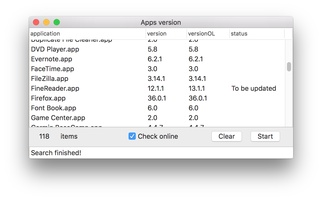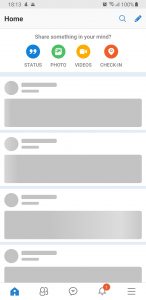S ince navigator.appVersion does not simply hold a value, like 2, 3 or 4, but rather would hold a text, like '3.0b4Gold (Win95; I)', we need to make a little check of the text before we can save a more convenient value in the variable called browserversion.
- For that you need to define a variable called appVersion with the initial version in this format: 1.0.0. Because UWP package version format is like 1.0.0.0, you have to concatenate another '0' at the end of appVersion. If you're a desktop developer, you might not like PowerShell or bash scripts.
- Appversion Mac 1.3 Appversion お使いの Mac にインストールされているアプリケーションが最新のコンピューターと 1 つを更新する必要を知っていることができるアシスタントします。.
Versioning is a critical component of your app upgrade and maintenancestrategy. Versioning is important because:
- Users need to have specific information about the app version thatis installed on their devices and the upgrade versions available forinstallation.
- Other apps — including other apps that you publish asa suite — need to query the system for your app's version, todetermine compatibility and identify dependencies.
- Services through which you will publish your app(s) may also need toquery your app for its version, so that they can display the version tousers. A publishing service may also need to check the app version todetermine compatibility and establish upgrade/downgrade relationships.

The Android system uses your app's version information to protect against downgrades.The system does not use app version information to enforce restrictions on upgrades or compatibility of third-party apps. Your app must enforce any version restrictions and should tell users about them.
The Android system does enforce system version compatibility as expressed by the minSdkVersion setting in the build files. This setting allows an app to specify the minimum system API with which it is compatible. For more information see Specifying Minimum System API Version.
Set application version information
To define the version information for your app, set values for the version settings in the Gradle build files. These values are then merged into your app's manifest file during the build process.
Terraria Apk Version 1.3
Note: If your app defines the app version directly in the <manifest> element, the version values in the Gradle build file will override the settings in the manifest. Additionally, defining these settings in the Gradle build files allows you to specify different values for different versions of your app. For greater flexibility and to avoid potential overwriting when the manifest is merged, you should remove these attributes from the <manifest> element and define your version settings in the Gradle build files instead.
Two settings are available, and you should always define values for both of them:
versionCode— A positive integer used as an internal version number. This number is used only to determine whether one version is more recent than another, with higher numbers indicating more recent versions. This is not the version number shown to users; that number is set by theversionNamesetting, below. The Android system uses theversionCodevalue to protect against downgrades by preventing users from installing an APK with a lowerversionCodethan the version currently installed on their device.The value is a positive integer so that other apps can programmatically evaluate it, for example to check an upgrade or downgrade relationship. You can set the value to any positive integer you want, however you should make sure that each successive release of your app uses a greater value. You cannot upload an APK to the Play Store with a
versionCodeyou have already used for a previous version.Note: In some specific situations, you might wish to upload a version of your app with a lower
versionCodethan the most recent version. For example, if you are publishing multiple APKs, you might have pre-setversionCoderanges for specific APKs. For more about assigningversionCodevalues for multiple APKs, see Multiple APK Support.Typically, you would release the first version of your app with
versionCodeset to 1, then monotonically increase the value with each release, regardless of whether the release constitutes a major or minor release. This means that theversionCodevalue does not necessarily have a strong resemblance to the app release version that is visible to the user (seeversionName, below). Apps and publishing services should not display this version value to users.Warning: The greatest value Google Play allows for
versionCodeis 2100000000.versionName— A string used as the version number shown to users. This setting can be specified as a raw string or as a reference to a string resource.The value is a string so that you can describe the app version as a <major>.<minor>.<point> string, or as any other type of absolute or relative version identifier. The
versionNamehas no purpose other than to be displayed to users.
You can define default values for these settings by including them in the defaultConfig {} block, nested inside the android {} block of your module's build.gradle file. You can then override these default values for different versions of your app by defining separate values for individual build types or product flavors. The following build.gradle file shows the versionCode and versionName settings in the defaultConfig {} block, as well as the productFlavors {} block.
In the defaultConfig {} block of this example, the versionCode value indicates that the current APK contains the second release of the app, and the versionName string specifies that it will appear to users as version 1.1. This build.gradle file also defines two product flavors, 'demo' and 'full.' Since the 'demo' product flavor defines versionName as '1.1-demo', the 'demo' build uses this versionName instead of the default value. The 'full' product flavor block does not define versionName, so it uses the default value of '1.1'.
The Android framework provides an API to let you query the systemfor version information about your app. To obtain version information,use thegetPackageInfo(java.lang.String, int)method of PackageManager.
Specify API level requirements
Lulubox Apk Version 1.36
If your app requires a specific minimum version of the Androidplatform, you can specify that version requirement as API level settings in the app's build.gradle file. During the build process, these settings are merged into your app's manifest file. Specifying API level requirements ensures that your app can only be installed on devices that are running a compatible version of the Android platform.
Note: If you specify API level requirements directly in your app's manifest file, the corresponding settings in the build files will override the settings in the manifest file. Additionally, defining these settings in the Gradle build files allows you to specify different values for different versions of your app. For greater flexibility and to avoid potential overwriting when the manifest is merged, you should remove these attributes from the <uses-sdk> element and define your API level settings in the Gradle build files instead.
There are two API level settings available:
minSdkVersion— The minimum versionof the Android platform on which the app will run, specifiedby the platform's API level identifier.targetSdkVersion— Specifies the API levelon which the app is designed to run. In some cases, this allows theapp to use manifest elements or behaviors defined in the targetAPI level, rather than being restricted to using only those definedfor the minimum API level.
Pgt+ Apk Version 1.3
To specify default API level requirements in a build.gradle file, add one or more of the settings above to the defaultConfig {} block, nested inside the android {} block. You can also override these default values for different versions of your app by adding the settings to build types or product flavors. The following build.gradle file specifies default minSdkVersion and targetSdkVersion settings in the defaultConfig {} block and overrides minSdkVersion for one product flavor.
App Version 1.7.5.0
When preparing to install your app, the system checks the value of these settings and compares them to the system version. If theminSdkVersion value is greater than the system version, thesystem prevents the installation of the app.

Terraria Apk Version 1.3.0.7.7
If you do not specify these settings, the system assumes that your app is compatible with all platform versions.
App Version 1.0.31251.0
For more information, see the <uses-sdk> manifest element documentation and the API Levels document. For Gradle build settings, see Configure Build Variants.

